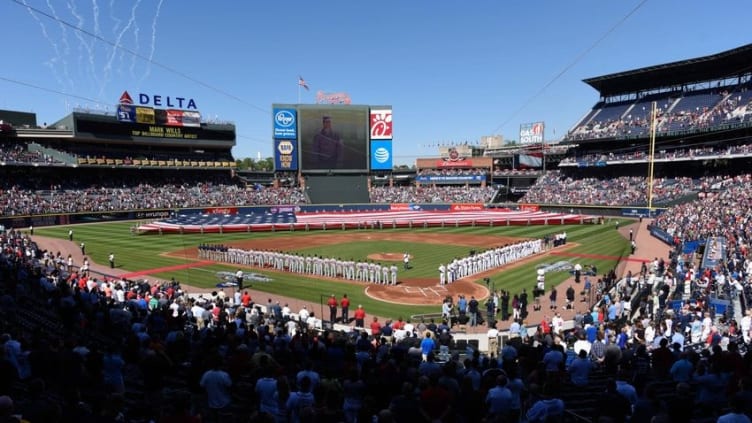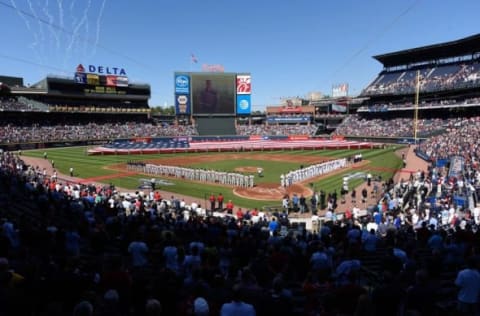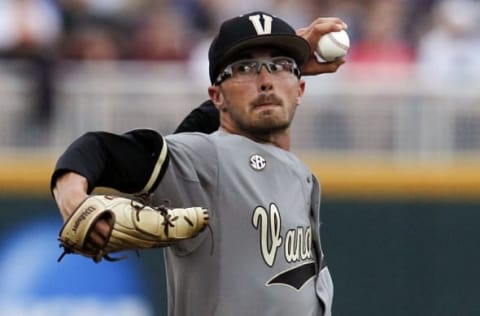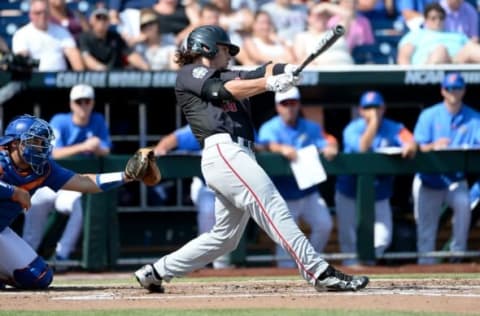Atlanta Braves 2016-2017 Top 100 Prospects: 100-91


The Atlanta Braves have an incredible farm system, and Benjamin Chase has taken up Tomahawk Take’s minor league coverage of that system. This is his top 100 prospects in the Atlanta Braves system!
An Introduction
This is my second undertaking of an Atlanta Braves Top 100 Prospects list.
I will be honest – it was much tougher this season. Last year, I did consider just under 150 names that I considered as worthy of being on the top 100 list, but the qualifications were basically “did not look bad statistically” or “heard at least one positive thing”.
This year I knew was going to be much deeper, so I upped my personal requirements even for consideration, and I had 173 names on the initial list that I made to start sorting out from.
First, the methodology. This list is not a list of the guys who have the most talent from 1-100 as that wouldn’t tell us what we really want to know. This is an evaluation of who has the talent, the mental makeup, and the work ethic to turn their talent into a major league baseball player.
The reality is that of these 100 players, the Braves would be doing exceptionally well if 25 of them played more than a brief stint with the major league club. That part does need to be kept in mind as we continue through this list.
That does not mean that someone who is a #98 on this list can’t have a major league career. What I look at is the level of impact a player will have IF he does make the major leagues. A guy who will be an impact hitter or not make it at all will likely get rated higher than a guy who won’t make it as a starter or a late-inning reliever, but he has a good shot to be a major league middle reliever.
All players who have not exceeded rookie requirements are eligible for this list, even if they’ve played in the major leagues already.
I will have a post on Friday after the entire list is revealed that presents the list in a pure list format with no evaluation on each player for reference in the future. These posts will have more in-depth evaluation of each player in the list.
I also intend to update this list sometime before spring training begins with any off season acquisitions that the Braves make, so I won’t be updating the list as each trade/rule V pick/waiver claim is made, it will all be at that time.
With that said, let’s take a look at this post’s focus, #91-100 on the list!
Next: #100 & #99
Zachary Bird in the bullpen 5-19-15 pic.twitter.com/8Kukpgku0e
— TheJerryEspinoza (@JEspinoza1634) May 20, 2015
100. Zachary Bird, RHP
More from Tomahawk Take
- Atlanta Braves 2012 Prospect Review: Joey Terdoslavich
- Braves News: Braves sign Fuentes, Andruw’s HOF candidacy, more
- The Weakest Braves Homers Since 2015
- Atlanta Braves Sign Joshua Fuentes to Minor League Deal
- Braves News: New Year’s Eve comes with several questions about the 2023 Braves
The Braves acquired Bird from the Dodgers in trade last summer. Bird is a Mississippi native, and the Braves pushed him to AA Mississippi to finish 2015 even though he wasn’t pitching all that well with high-A in the Dodgers system.
While Bird was able to put up a 4.26 ERA in 3 starts, he also showed some signs to worry on as he walked 12 and struck out 8 in his time with Mississippi.
The Braves sent him to high-A Carolina to transition him to the bullpen. The transition, however, did not go well. Bird made 28 appearances on the season, pitching 47 2/3 innings before he was shut down with an “injury” for the season. In that time, he had an ERA of 8.87 and a 2.12 WHIP with a 39/34 BB/K ratio.
While Bird featured a four-pitch mix, he dropped his below-average curve ball and his seldom-used change when he moved to the bullpen. Typically, a move to the bullpen will allow a pitcher’s velocity to play up, but Bird seemed to be attempting to force the velocity, and while he did add roughly a single MPH to about 96-97 on the top end, he flattened out the pitch significantly, and without any deception, batters were able to tee off on the pitch.
His slider has arm side run and sink, but he simply has no clue where it is going. It could be an effective out pitch if he could get the pitch in the zone, which is the only reason that he is even on this list rather than other options that could take his place.
Last season, in my initial list, I had one Mauricio Cabrera ranked #99. He then went to the Arizona Fall League and showed enough to move up to the middle of my rankings, but I’m still very wary of Cabrera long-term, in spite of big league success in 2016.
Bird falls in that same vein. He’ll likely repeat Carolina this year and hopefully, he can take off with slider control and command. He will be eligible for the Rule 5 draft this offseason, and it’s highly unlikely that the Braves would protect him, so he could be lost to the Rule 5.
99. Lisandro Santos, LHP
The Braves signed Santos for $130K this past July. Due to already being 17, he was allowed to pitch this summer in the Dominican Summer League. He showed very well in just 4 appearances, allowing 4 unearned runs over 6 2/3 innings with a 1.05 WHIP.
Scouting reports are tough to find, but I do talk with one guy who spends time down in the Dominican every summer, and he caught a performance of Santos. His report is the main reason that Santos made this list. His report was a heavy fastball that could touch lower mid-90s but sat more in the upper 80s. His breaking pitch had very good depth, and the scout said he’s either throwing a slider with reduced velocity or a curve with minimal hump in its path to the plate.
As with any player at 17 or out of the DSL, Santos is a long-term wild card, but he showed an impressive ability to avoid the barrel of bats in his short time this year, relying on his defense, though that can be a benefit and negative all at the same time.
Next: #98 & #97
@aguilasdelzulia pic.twitter.com/hNGamf0Oll
— reilys blanco (@SoySuChino18) November 9, 2015
98. Reilys Blanco, 3B
Blanco was signed last summer, but so late (August 10th) that he could not play anywhere in 2015. An “older” signing (something the Braves tend to specialize in within the Latin market), Blanco is a switch hitter that’s listed at 5’10, 150 pounds. The report I got was that he’s more 175-ish, but still that’s a pretty small guy, so it’s not surprising why he slipped through the typical tryout camps.
Blanco has very good speed and an above-average throwing arm. The guy I talked with believes that Blanco may have attended a tryout or two as a pitcher, though that also would be small for a pitcher. Blanco played mostly third base, but he also spent time at second base and left field. The reports I got were that Blanco could handle third base, but his size is not prototypical at the position.
The highest grades for Blanco came in his offensive ability. He showed an ability to recognize spin and lay off breaking stuff. He is not a guy with present power, and he doesn’t project to be a big time power hitter. He also doesn’t have elite speed, probably grading a 55-60 on the 20-80 scale.
His carrying tools offensively will be his contact and eye, and his .307/.374 BA/OBP line in DSL this year was not simply a product of a small sample size. He’s already 20, so he’s likely needing to move forward fairly quickly to have a future, but there’s enough here to dream on a little.
With Mike Foltynewicz graduating from @Braves Top 30 list, RHP Steve Janas/@SJanas_11 enters: http://t.co/wp6x6fyDNZ pic.twitter.com/ICGc9SqtXd
— MLB Pipeline (@MLBPipeline) May 15, 2015
97. Steve Janas, RHP
Janas was drafted by the Braves in 2013 out of Kennesaw State University in the 6th round. He had two fairly nondescript seasons in the lower levels of the system in 2014 and 2015 before really blowing up last season. He started the season by posting a 0.49 ERA over his first 6 starts (covering 37 innings) with Carolina before he was promoted to Mississippi, where he took the ball on a regular basis and showed he wasn’t out of place.
Janas utilized a five-pitch repertoire as a starter with a fastball, sinker, curve, change, and a cutter that he added in 2015. Moving to the bullpen, he actually utilized all five pitches in games I watched, but he primarily featured his sinker, cutter, and change.
Janas did see an uptick in velocity in the bullpen, but not really in where he sat, more in where he could reach in single-pitch increments, as he sat the sinker and cutter in the low 90s, touching 95 with both. His four-seam fastball did top out at 97, but he rarely uses it.
The change is arguably the best change up in the entire system. It follows his sinker very well with about 10 MPH separation between the two pitches and opposite sink break, where as the sinker has its sink with slight arm side run, the change dips with slight glove side run.
Janas started out in Mississippi’s bullpen this year, working as a guy who could soak up a few innings as needed in the middle innings rather than a back-end guy. He was very productive, however, and he did earn a promotion to Gwinnett, where he continued to put up solid numbers. Overall, he posted a 2.75 ERA and 1.04 WHIP in 85 relief innings in 2016 with a 16/56 BB/K ratio.
Janas pounds the zone with his pitches, and none really have the type of movement to generate swing and miss, so he’s probably best suited as a ground ball specialist in the middle innings in the big leagues, akin to the role that Joe Blanton played with the Dodgers this season.
Next: #96 & #95

96. Phil Pfeifer, LHP
Acquired from the Dodgers, Pfeifer was a 2015 draft pick out of Vanderbilt University in the 3rd round. He missed nearly a full season as he dealt with substance abuse issues, but he’s come out on the better side of things for it.
Pfeifer was used exclusively in relief this season, and his stuff may work better long-term out of the bullpen as his upside is limited in the starting role.
He works with a fastball that sits around 90 and can touch 92-93. He has a solid curve and change, but the thing that should help him be effective out of the bullpen is the big of deception in his delivery.
Pfeifer in other organizations would likely get more of a chance to start, but he’ll have a chance to make it to the big leagues in 2017 in the Braves organization out of the bullpen, where he’d be significantly lower on the food chain of lefty starters.
Pfeifer pitched with four teams last year between the Dodgers and Braves organizations, posting a combined 3.02 ERA in 34 appearances and 47 2/3 innings with a 1.32 and a 28/60 BB/K ratio. His deception played up well in the bullpen and limited quality contact, but his control slipped at times.
He does keep the ball in the park, allowing only one home run, and it was while he was a member of the Rancho Cucamonga team in the Cal League, a notorious hitter’s league.
A's Alum Matt Custred Atlanta Braves Minor League Monday, Labor Day Edition http://t.co/8lGwgLJi2y pic.twitter.com/KV5DZy7r8b
— Arlington A's Baseball (@arlingtonas1988) September 17, 2015
95. Matt Custred, RHP
Custred was a find for the Braves, who plucked him out of Texas Tech University in the 31st round of the 2015 draft. He put up video game numbers in the two rookie leagues for the Braves in 2015, posting a 1.38 combined ERA between Danville and GCL in 32 2/3 innings with a 0.80 WHIP and a 9/46 BB/K ratio.
Many had big hopes for Custred to take a step forward in a hurry when he was part of the Rome bullpen to start the season, but the pinpoint control that Custred displayed in 2015 left him in 2016, and he had significant issues with walks. His stuff was still near impossible for hitters to square up, and he allowed a .173 average against on the season, posting near equal numbers against right-handed and left-handed hitters.
Custred is a huge guy (6’6, 240 listed, but likely more like 250-260), and like a lot of bigger guys, he had trouble with his control when his delivery got off track. This was very evident when reviewing his season splits. Of his 36 walks on the season, 9 came in two months, April and July. When his delivery is off, he’s really off in his control until he can get it back on track.
Custred has a heavy, hard fastball that tops out in the upper-90s, but is more notable for its weight. His secondary pitch is a hard curve that he gets a lot of swing and miss on when he’s at his best. However, when those mechanics got off, that curve was all over the place, and hitters could sit on the fastball, which is why you see that Custred’s two lowest strikeout percentage months are also April and July of this last year.
Custred has a big-time upside as a back-end guy. I would love to see him with a third pitch, personally, along the lines of a split-finger or a cutter that he can use to get swings when his mechanics aren’t at peak, rather than being completely without a second weapon in those moments. If he can find whatever trigger will help him to keep his delivery repeatable, he could rocket through the system and would have a very bright future as a back-end guy, but his size makes sustaining that delivery a constant concern going forward.
Next: #94 & #93

94. Tyler Neslony, OF
Atlanta has had a good pipeline from Texas Tech University in the last few years, and Neslony was yet another one brought in this year through the draft, picked in the 9th round. Neslony was one of the last picks to sign with the Braves before the signing deadline, but he made up for lost time by quickly advancing beyond advanced rookie Danville and finishing his season in Rome in his first year.
Neslony was viewed as a senior sign outfielder that didn’t have a big future in the big leagues and would end up as roster filler. Neslony is not a guy who has big power or elite speed, but he does have decent pitch recognition and showed a better ability to adjust his approach within an at bat than had been advertised.
He did show to tire by the end of the season, which does make some sense as he had played from February straight through in meaningful games due to Texas Tech’s long run in the College World Series this year. Neslony shows a high baseball IQ that allows tools that scouts may have graded as fringe or below-average to play up.
I think Neslony is a future left fielder if he does start, but can pass in right field. He could be a solid backup type of outfielder that swings from the left side and has average skills across the board that his high baseball instincts will help to play up.
93. Juan Contreras, RHP
Contreras was one of the major signings for the Braves in the July 2nd international free agent class. Contreras is only 6’1 currently, but already he has the ability to stay tall through his delivery to create an excellent downward plane on his mid-90s fastball. Many believe that as he fills out, Contreras will be a guy that reaches the upper-90s and even triple digits in velocity.
The big question for Contreras to answer will be whether he is able to locate everything else in his pitching repertoire beyond his big fastball to project as a starter, but there is no debating the electricity in the arm. Without any pro experience, it’s hard to rate him any higher, but the Braves were obviously big fans, paying Contreras $1.2M to sign.
Next: #92 & #91
#Braves are staying busy on int'l market. Clubs signs RHP Yefri Del Rosario, 16, to $1M deal. @MLBPipeline pic.twitter.com/CpncXs2akj
— Jesse Sanchez (@JesseSanchezMLB) July 30, 2016
92. Yefri Del Rosario, RHP
Del Rosario was the cherry on the top of the Braves’ big July 2nd international free agent class. He signed at the end of July after deciding between the Braves and Indians. The Braves were able to sway Del Rosario for $1M, snagging the top-30 overall international prospect for less than they paid other arms they grabbed, including Juan Contreras.
Del Rosario has an impressive pitch mix already at 16 (he turned 17 at the end of September, so will pitch 2017 at 17 years old). He has a fastball that touches 94 and sits around 90. He has an advanced feel for a change that belies his age, and he has the ability to snap a breaking pitch that has a bit of slurve to it, so it’s difficult to nail down as a pure slider or curve.
While Del Rosario has an excellent pitch mix now, the biggest worry lies in his mechanics and size. He’s currently 5’11, 165 pounds, and likely doesn’t project to be a guy who’s 6’5 even with some expected growth. His mechanics currently have some worries due to arm drag within his delivery that leads to control issues and could lead to future injury risk.
This could lead to Yefri becoming a reliever long term, but obviously at 16, there’s plenty of development left to determine on him before forcing such concerns.
91. Carlos Lopez, RHP
Last season, Lopez put up a solid season after signing in February of 2015 out of Mexico just before turning 17. He posted a 3.64 ERA and 1.18 WHIP in 29 2/3 innings pitched with an 8/33 BB/K ratio. That got the attention of a lot of those who review stat lines, and there were many excited to see what the tall righty did in the GCL this season.
Except he didn’t arrive in Florida. Lopez pitched a second season with DSL, and while his ERA looked very good, it hid a ton of unearned runs as he had a FIP over 3 runs higher than his ERA. He posted a 1.53 ERA and 1.64 WHIP over 17 2/3 innings with a rough 14/14 BB/K. That’s correct, he walked a batter for every one he struck out.
In talking with someone who saw him both seasons, Lopez really didn’t show anything different between the two seasons in raw stuff, but what he did show was that his big frame (he’s listed at 6’4 and 175 pounds, but the scout I talked with reported him at more like 6’5-6’6 and still 180-190 in weight) was all arms and legs and that he all-too-often got in his own way in delivering the ball.
Next: Braves Minor League Database
Hope you enjoyed the first installment! Look for 81-90 this afternoon!!